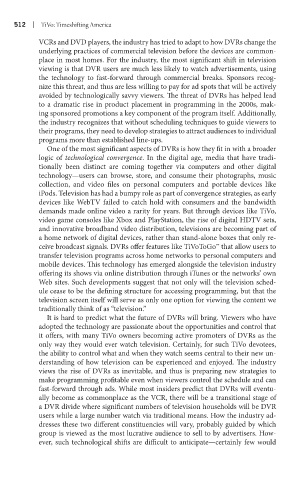Page 533 - Battleground The Media Volume 1 and 2
P. 533
1 | T Vo: T mesh ft ng Amer ca
VCRs and DVD players, the industry has tried to adapt to how DVRs change the
underlying practices of commercial television before the devices are common-
place in most homes. For the industry, the most significant shift in television
viewing is that DVR users are much less likely to watch advertisements, using
the technology to fast-forward through commercial breaks. Sponsors recog-
nize this threat, and thus are less willing to pay for ad spots that will be actively
avoided by technologically savvy viewers. The threat of DVRs has helped lead
to a dramatic rise in product placement in programming in the 2000s, mak-
ing sponsored promotions a key component of the program itself. Additionally,
the industry recognizes that without scheduling techniques to guide viewers to
their programs, they need to develop strategies to attract audiences to individual
programs more than established line-ups.
One of the most significant aspects of DVRs is how they fit in with a broader
logic of technological convergence. In the digital age, media that have tradi-
tionally been distinct are coming together via computers and other digital
technology—users can browse, store, and consume their photographs, music
collection, and video files on personal computers and portable devices like
iPods. Television has had a bumpy role as part of convergence strategies, as early
devices like WebTV failed to catch hold with consumers and the bandwidth
demands made online video a rarity for years. But through devices like TiVo,
video game consoles like Xbox and PlayStation, the rise of digital HDTV sets,
and innovative broadband video distribution, televisions are becoming part of
a home network of digital devices, rather than stand-alone boxes that only re-
ceive broadcast signals. DVRs offer features like TiVoToGo™ that allow users to
transfer television programs across home networks to personal computers and
mobile devices. This technology has emerged alongside the television industry
offering its shows via online distribution through iTunes or the networks’ own
Web sites. Such developments suggest that not only will the television sched-
ule cease to be the defining structure for accessing programming, but that the
television screen itself will serve as only one option for viewing the content we
traditionally think of as “television.”
It is hard to predict what the future of DVRs will bring. Viewers who have
adopted the technology are passionate about the opportunities and control that
it offers, with many TiVo owners becoming active promoters of DVRs as the
only way they would ever watch television. Certainly, for such TiVo devotees,
the ability to control what and when they watch seems central to their new un-
derstanding of how television can be experienced and enjoyed. The industry
views the rise of DVRs as inevitable, and thus is preparing new strategies to
make programming profitable even when viewers control the schedule and can
fast-forward through ads. While most insiders predict that DVRs will eventu-
ally become as commonplace as the VCR, there will be a transitional stage of
a DVR divide where significant numbers of television households will be DVR
users while a large number watch via traditional means. How the industry ad-
dresses these two different constituencies will vary, probably guided by which
group is viewed as the most lucrative audience to sell to by advertisers. How-
ever, such technological shifts are difficult to anticipate—certainly few would

